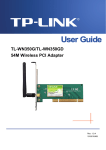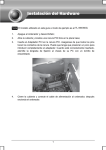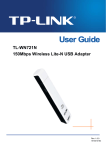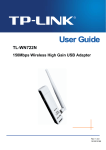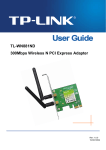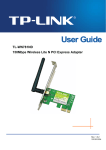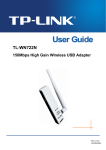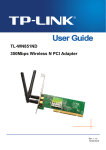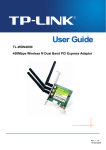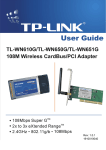Download TP-LINK 54Mbps Wireless PCI Adapter
Transcript
TL-WN350G/TL-WN350GD 54M Wireless PCI Adapter User Guide TL-WN350G/TL-WN350GD 54M Wireless PCI Adapter Rev: 1.0.1 1910010124 TL-WN350G/TL-WN350GD 54M Wireless PCI Adapter User Guide COPYRIGHT & TRADEMARKS Specifications are subject to change without notice. is a registered trademark of TP-LINK TECHNOLOGIES CO., LTD. Other brands and product names are trademarks or registered trademarks of their respective holders. No part of the specifications may be reproduced in any form or by any means or used to make any derivative such as translation, transformation, or adaptation without permission from TP-LINK TECHNOLOGIES CO., LTD. Copyright © 2008 TP-LINK TECHNOLOGIES CO., LTD. All rights reserved. http://www.tp-link.com TL-WN350G/TL-WN350GD 54M Wireless PCI Adapter User Guide FCC STATEMENT This equipment has been tested and found to comply with the limits for a class B digital device, pursuant to part 15 of the FCC Rules. These limits are designed to provide reasonable protection against harmful interference in a residential installation. This equipment generates, uses and can radiate radio frequency energy and, if not installed and used in accordance with the instructions, may cause harmful interference to radio communications. However, there is no guarantee that interference will not occur in a particular installation. If this equipment does cause harmful interference to radio or television reception, which can be determined by turning the equipment off and on, the user is encouraged to try to correct the interference by one or more of the following measures: • Reorient or relocate the receiving antenna. • Increase the separation between the equipment and receiver. • Connect the equipment into an outlet on a circuit different from that to which the receiver is connected. • Consult the dealer or an experienced radio/TV technician for help. This device complies with Part 15 of the FCC Rules. Operation is subject to the following two conditions: 1) This device may not cause harmful interference. 2) This device must accept any interference received, including interference that may cause undesired operation. Changes or modifications to this unit not expressly approved by the party responsible for compliance could void the user's authority to operate the equipment. FCC RF Radiation Exposure Statement: This equipment complies with FCC RF radiation exposure limits set forth for an uncontrolled environment. This device and its antenna must not be co-located or operating in conjunction with any other antenna or transmitter. “To comply with FCC RF exposure compliance requirements, the antenna used for this transmitter must be installed to provide a separation distance of at least 20 cm from all persons and must not be co-located or operating in conjunction with any other antenna or transmitter”. TL-WN350G/TL-WN350GD 54M Wireless PCI Adapter User Guide CE Mark Warning This is a class B product. In a domestic environment, this product may cause radio interference, in which case the user may be required to take adequate measures. National Restrictions 2400.0-2483.5 MHz Country Restriction Reason/remark General authorization required for outdoor use and Bulgaria public service France Outdoor use limited to 10 Military Radiolocation use. Refarming of the 2.4 GHz mW e.i.r.p. within the band band has been ongoing in recent years to allow current 2454-2483.5 MHz relaxed regulation. Full implementation planned 2012 If used outside of own premises, general authorization is Italy required General authorization required for network and service Luxembourg None supply(not for spectrum) This subsection does not apply for the geographical area Norway Implemented within a radius of 20 km from the centre of Ny-Ålesund Russian Federation Note: Please don’t use the product outdoors in France. Only for indoor applications TL-WN350G/TL-WN350GD 54M Wireless PCI Adapter User Guide CONTENTS Package Contents ..................................................................................6 Chapter 1 Introduction .........................................................................1 1.1 Overview of the product .............................................................................................. 1 1.2 Features ...................................................................................................................... 1 1.3 LED Status .................................................................................................................. 1 Chapter 2 Installation Guide ................................................................2 2.1 Hardware Installation................................................................................................... 2 2.2 Software Installation .................................................................................................... 2 2.2.1 Overview.................................................................................................................. 2 2.2.2 Software Installation for Windows XP ...................................................................... 2 2.2.3 Software Installation for Windows Vista................................................................... 9 Chapter 3 Configuration.....................................................................13 3.1 Current Status ........................................................................................................... 13 3.2 Profile Management .................................................................................................. 15 3.2.1 Add or Modify a Configuration Profile .................................................................... 15 3.2.2 Remove a profile.................................................................................................... 20 3.2.3 Switch another Profile............................................................................................ 20 3.2.4 Export a Profile ...................................................................................................... 20 3.2.5 Import a Profile ...................................................................................................... 21 3.2.6 Scan Available Networks ....................................................................................... 21 3.2.7 Auto Profile Selection Management....................................................................... 22 3.3 Diagnostics................................................................................................................ 23 3.3.1 Check Driver Information ....................................................................................... 24 3.3.2 Check Receive and Transmit Statistical Information.............................................. 24 Appendix A: Specifications.................................................................25 Appendix B: Glossary..........................................................................26 TL-WN350G/TL-WN350GD 54M Wireless PCI Adapter User Guide Package Contents The following items should be found in your package: ¾ ¾ ¾ One TL-WN350G/TL-WN350GD 54M Wireless PCI Adapter Quick Installation Guide One Resource CD for TL-WN350G/TL-WN350GD, including: • • • TP-LINK Wireless Client Utility (TWCU) and Drivers User Guide Other Helpful Information ) Note: Make sure that the package contains the above items. If any of the listed items are damaged or missing, please contact with your distributor. Conventions: The ‘Adapter’ and ‘PCI Adapter’ mentioned in this User guide both TL-WN350G/TL-WN350GD 54M Wireless PCI Adapter without any explanations. stand for TL-WN350G/TL-WN350GD 54M Wireless PCI Adapter User Guide Chapter 1 Introduction Thank you for choosing the TL-WN350G/TL-WN350GD 54M Wireless PCI Adapter! 1.1 Overview of the product The TP-LINK TL-WN350G/TL-WN350GD 54M Wireless PCI Adapter will provide you the flexibility to install your PC in the most convenient location available, without the cost of running network cables. The Adapter's auto-sensing capability allows high packet transfer rate of up to 54Mbps for maximum throughput, or dynamic range shifting to lower speeds due to distance or operating limitations in an environment with a lot of electromagnetic interference. It can also interoperate with all 11Mbps wireless (802.11b) products. Your wireless communications are protected by up to 152-bit WEP and WPA encryption for high security. 1.2 Features ¾ Complies with IEEE802.11g, IEEE802.11b standards ¾ Supports WPA/WPA2 data security, IEEE802.1x authentication, TKIP/AES encryption, 64/128/152-bit WEP encryption ¾ Supports 54/48/36/24/18/12/9/6Mbps or 11/5.5/2/1Mbps wireless LAN data transfer rates ¾ Provides 32-bit PCI interface ¾ Supports Ad-Hoc and Infrastructure modes ¾ Supports roaming between access points when configured in Infrastructure mode ¾ Ease to configure and provides monitoring information ¾ Supports Windows 2000, XP, Vista32, Vista64 ¾ TL-WN350G adopts fixed antenna ¾ TL-WN350GD adopts detachable antenna 1.3 LED Status LED Status Indication The adapter is in an electricity saving status or Status Green Intermittently the adapter is already connected but is not transmitting or receiving data. Status Green On The adapter is on wake up status. Status Green Flashing The adapter is transmitting and receiving data. 1 TL-WN350G/TL-WN350GD 54M Wireless PCI Adapter User Guide Chapter 2 Installation Guide 2.1 Hardware Installation To install the Adapter, follow these steps listed below: 1. Turn off your desktop PC and disconnect the power. 2. Open your PC case and locate an available PCI slot on the motherboard. Remove the metal slot cover on the back of the PC. Check with your computer manufacturer for instructions if needed. 3. Slide the PCI Adapter into the PCI slot. Make sure that all of its pins are touching the slot's contacts. Once the adapter is firmly in place, secure its fastening tab to your PC's chassis with a mounting screw. Then, close your PC case. 4. 2.2 Reconnect your PC’s power and turn on your desktop PC. Software Installation 2.2.1 Overview The Adapter’s Setup Wizard will guide you through the Installation procedure for Windows 2000, XP, Vista32, and Vista64. The Setup Wizard will install the TP-LINK Wireless Client Utility (TWCU) and drivers. When you install the hardware before installing the software, the system will prompt “Found New Hardware Wizard”, click Cancel, and run the Setup Wizard program on the CD-ROM. The Setup steps for Windows 2000 and XP are very similar. The following setup steps are for Windows XP. 2.2.2 Software Installation for Windows XP 1. Insert the Resource CD into your CD-ROM drive, and open the folder named TL-WN350G/TL-WN350GD. Choose the proper folder according to your operating system and double-click Setup.exe to load the following screen. And then click Next To continue the installation. 2 TL-WN350G/TL-WN350GD 54M Wireless PCI Adapter User Guide Figure 2-1 2. You can click Cancel to end the installation in the screen above. Otherwise, the installation will continue, and then Figure 2-2 will display, click Next to continue. Figure 2-2 3. Choose a Setup type in Figure 2-3. It is recommended to select Install Client Utilities and Driver. Click Next to continue. 3 TL-WN350G/TL-WN350GD 54M Wireless PCI Adapter User Guide Figure 2-3 4. Click Browse to change the destination location for the software in Figure 2-4. After that, click Next to continue. Figure 2-4 5. Create a new folder name or select one from the Existing Folders list in Figure 2-5. It is recommended to keep the default setting. Click Next to continue. 4 TL-WN350G/TL-WN350GD 54M Wireless PCI Adapter User Guide Figure 2-5 6. Please read the information carefully in Figure 2-6, and click “Next” to continue Figure 2-6 7. Choose TP-LINK Wireless Client Utility (TWCU) and Supplicant as a tool to configure the client adapter on the screen as below, and click Next to continue. 5 TL-WN350G/TL-WN350GD 54M Wireless PCI Adapter User Guide Figure 2-7 ) Note: In Windows 2000, Figure 2-6 and Figure 2-7 won’t display, and it will go to Figure 2-8 directly. 8. Choose “Do Not Install Single Sign On Feature Set” In Figure 2-8, and the system won’t reboot after the installation. If you choose “Install Single Sign On feature set”, the system will reboot later. Click Next to continue. Figure 2-8 6 TL-WN350G/TL-WN350GD 9. 54M Wireless PCI Adapter User Guide Click ok to continue the Installation in Figure 2-9. Figure 2-9 10. Wait for the installation program to run automatically. Figure 2-10 11. During the step, the Setup Wizard will notify you of how to proceed with the installation as shown below. Our drivers have been tested thoroughly, and are able to work with the operating system. Click Continue Anyway to continue the Installation. 7 TL-WN350G/TL-WN350GD 54M Wireless PCI Adapter User Guide Figure 2-11 ) Note: In Windows 2000, the warning screen is shown below (Figure 2-12), and please select Yes to continue installation. Figure 2-12 12. After all the steps above, you will see the screen below, click Finish to complete the installation. 8 TL-WN350G/TL-WN350GD 54M Wireless PCI Adapter User Guide Figure 2-13 2.2.3 Software Installation for Windows Vista 1. Insert the Resource CD into your CD-ROM drive, and open the folder with the same name as your product. Then double-click Setup.exe in the proper folder according to your operating system to start the installation. And then Figure 2-14 will appear; Click Cancel to end the installation in the screen. Otherwise, the installation will continue. Figure 2-14 9 TL-WN350G/TL-WN350GD 2. 54M Wireless PCI Adapter User Guide Click Next in the screen below (shown in Figure 2-15) to continue, you can click Cancel to end the installation. Figure 2-15 3. Click ok to continue the Installation in Figure 2-16 Figure 2-16 4. After that, the files will be copied as the next screen shown (shown in Figure 2-17). To end the Installation, click Cancel. 10 TL-WN350G/TL-WN350GD 54M Wireless PCI Adapter User Guide Figure 2-17 ) Note: During the installation, the system will warn about Windows Security testing, please click “Install this driver software anyway” to continue the installation. Figure 2-18 5. Click the Finish button to complete. 11 TL-WN350G/TL-WN350GD 54M Wireless PCI Adapter User Guide Figure 2-19 12 TL-WN350G/TL-WN350GD 54M Wireless PCI Adapter User Guide Chapter 3 Configuration TP-LINK Wireless PCI Adapter TL-WN350G/TL-WN350GD can be configured by TP-LINK Wireless Client Utility (TWCU). This chapter describes how to configure your TP-LINK Wireless PCI Adapter for wireless connectivity on your Wireless Local Area Network (WLAN) and use the data security encryption features. After Installing the Adapter, the Adapter’s tray icon will appear in your system tray. It appears at the bottom of the screen, and shows the signal strength using color and the received signal strength indication (RSSI). If the icon is gray, there is no connection. If the icon is red, there is poor signal strength and the RSSI is less than 5dB. If the icon is yellow, there is poor signal strength and the RSSI is between 5dB and 10dB. If the icon is green, there is good signal strength and the RSSI is between 10dB and 20dB. If the icon is green, there is excellent signal strength and the RSSI is more than 20dB. Double-click the icon and the TWCU will run. You can also run the utility by clicking the Start>Program>TP-LINK>TWCU>TP-LINK Wireless Client Utility. The TWCU provides integrated and easy tools to: ¾ Display current status information ¾ Edit and add configuration profiles ¾ Display current diagnostics information The section below introduces these above capabilities. 3.1 Current Status The Current Status tab contains general information about the program and its operations. The Current Status tab does not require any configurations. 13 TL-WN350G/TL-WN350GD 54M Wireless PCI Adapter User Guide Figure 3-1 The following table describes the items found on the Current Status screen. ¾ Profile Name - This shows the name of current selected configuration profile. The configuration of Profile name will be described on the General tab of Profile Management. ¾ Link Status - This shows whether the station is associated to the wireless network. ¾ Wireless Mode - Here displays the wireless mode. It will be configured on the Advanced tab of Profile Management. ¾ Network Type - The type of network and the station currently connected are shown here. The options include: • • Infrastructure (access point) Ad Hoc ) Note: You can configure the network type on the Advanced tab of Profile Management. ¾ IP Address - This displays the computer’s IP address. ¾ Current Channel - This shows the currently connected channel. ¾ Data Encryption - Here displays the encryption type the driver is using. You can configure it on the Security tab of Profile Management. ¾ Server Based Authentication - This shows whether the server based authentication is used. ¾ Signal Strength - This shows the strength of the signal. Click Advanced on the screen above, you can see advanced information about the program and its operations. For more information, please refer to the help file of the utility. 14 TL-WN350G/TL-WN350GD 3.2 54M Wireless PCI Adapter User Guide Profile Management Click the Profile Management tab of the TWCU and the next screen will appear (shown in Figure 3-2). The Profile Management screen provides tools to: ¾ Add a new profile ¾ Modify a profile ¾ Remove a profile ¾ Switch to another Profile ¾ Import a Profile ¾ Export a Profile ¾ Scan Available Networks ¾ Order profiles Figure 3-2 3.2.1 Add or Modify a Configuration Profile To add a new configuration profile, click New on the Profile Management tab. To modify a configuration profile, select the configuration profile from the Profile list and click Modify. Then you will see the Management dialog box (shown in Figure 3-3). 1. Edit the General tab ¾ Profile Name - Please enter the Profile name which identifies the configuration profile. This name must be unique. Note that the profile names are not case-sensitive. ¾ Client Name - Please enter the Profile name which identifies the client machine. ¾ Network Names (SSIDs) - Please enter the IEEE 802.11 wireless network name. This field has a maximum limit of 32 characters. 15 TL-WN350G/TL-WN350GD 54M Wireless PCI Adapter User Guide Figure 3-3 2. Edit the Security tab Select the Security tab in the screen above, then you can edit the fields to configure the profile. To define the security mode, select the radio button of the desired security mode as follows. 16 TL-WN350G/TL-WN350GD 54M Wireless PCI Adapter User Guide Figure 3-4 ¾ WPA/WPA2- Wi-Fi Protected Access ¾ WPA/WPA2 Passphrase- Wi-Fi Protected Access Passphrase ¾ 802.1x- Enables 802.1x security. ¾ Pre-Shared Key (Static WEP)- Enables the use of shared keys that are defined on both the access point and the station. To define shared encryption keys, choose the Shared Key radio button and click Configure to fill in the Define Shared Keys window (shown in Figure 3-5). ¾ None- No security (not recommended). ) Note: If the access point to which the Wireless PCI Adapter is associated has WEP set and the client has WEP enabled, make sure that Allow Association to Mixed Cells is checked on the Security Tab to allow association. To complete WEP encryption configuration, you must select the 802.11 Authentication Mode as appropriate on the Advanced tab of this Profile Management dialog. To configure the Encryption Keys under the Pre-Shared keys (Static WEP) Security mode: 17 TL-WN350G/TL-WN350GD 54M Wireless PCI Adapter User Guide Figure 3-5 3. Edit the Advanced tab This screen below allows you to make advanced configuration for the profile. Figure 3-6 ¾ Power Save Mode - Please select the power save mode in the drop-down list. • Maximum - Selects maximum mode to let the access point buffer incoming messages 18 TL-WN350G/TL-WN350GD 54M Wireless PCI Adapter User Guide for the Wireless PCI Adapter. The Adapter will detect the access point if any messages are waiting periodically. ¾ • Normal - Normal mode uses maximum when retrieving a large number of packets, then switches back to power save mode after retrieving the packets. • Off - Turns power saving off, thus powering up the Wireless PCI Adapter continuously for a short message response time. 802.11b Preamble- Selects the preamble setting in 802.11b. The default setting is Short & Long (access point mode), which allows both short and long headers in the 802.11b frames. The adapter can only use short radio headers if the access point supports and uses them. Set to Long Only to override short frames. ¾ Wireless Mode- Specifies 2.4 GHz 54 Mbps or 2.4 GHz 11 Mbps operation in an access point network. The Wireless PCI Adapter must match the wireless mode of the access point with which it associates. ¾ Wireless Mode when Starting an Ad Hoc Network- Specifies 2.4 GHz 54/11 Mbps to start an Ad Hoc network if no matching network name is found after scanning all available modes. This mode also allows the selection of the channel that the Wireless PCI Adapter uses. The channels available depend on the regulatory domain. If the adapter finds no other ad hoc adapters, the channel that the adapter starts the ad hoc network with will be selected automatically. The Wireless PCI Adapter must match the wireless mode and channel of the clients it associates. ¾ QoS- Select the option, the Adapter will provide the Quality of Service for the wireless connection. ¾ 802.11 Authentication Mode- Select which mode the Wireless PCI Adapter uses to authenticate to an access point: ¾ • Automatic causes the adapter to attempt authentication using shared, but switches it to open authentication if shared fails. • Open System enables an adapter to attempt authentication regardless of its WEP settings. It will only associate with the access point if the WEP keys on both the adapter and the access point match. • Shared-key only allows the adapter to associate with access points that have the same WEP key. Roaming- - You can select the Default, Very Low, Low, Normal, High in the drop-down list. It is recommended to keep the default setting. For infrastructure (access point) networks, click Preferred APs… to specify four access points at most to the client adapter that attempts to be associated to the access points. The four access points have different priorities; the frontal has the higher priority. 19 TL-WN350G/TL-WN350GD 54M Wireless PCI Adapter User Guide Figure 3-7 3.2.2 Remove a profile 1. 2. Go to the Profile Management tab (shown in Figure 3-2). Select the profile name in the Profiles List. 3. Click Remove. ) Note: The profile being used can’t be removed. 3.2.3 Switch another Profile 1. 2. Go to the Profile Management screen (shown in Figure 3-2). Select the profile name required in the Profiles List. 3. Click Activate. 3.2.4 Export a Profile 1. From the Profile Management screen (shown in Figure 3-2), highlight the profile to export. 2. 3. Click Export…, the Export Profile window will then appear below. Browse the directory to export the profile to. 4. Click Save. The profile should then be exported to the specified location. 20 TL-WN350G/TL-WN350GD 54M Wireless PCI Adapter User Guide Figure 3-8 3.2.5 1. Import a Profile 2. 3. From the Profile Management screen (shown in Figure 3-2), click Import…. Then the Import Profile will appear below. Browse to the directory where the profile is located. Highlight the profile name. 4. Click Open, the imported profile will then appear in the Profiles List. Figure 3-9 3.2.6 Scan Available Networks 1. Click Scan on the Profile Management screen (shown in Figure 3-2), the Available Infrastructure and Ad Hoc Networks window will appear below. 2. 3. Click Refresh to refresh the list at any time. Highlight a network name and click Activate to connect to an available network. If no configuration profile exists for that network, the Profile Management window will open the General tab screen. Fill in the Profile name and click OK to create the configuration profile for that network. 21 TL-WN350G/TL-WN350GD 54M Wireless PCI Adapter User Guide Figure 3-10 3.2.7 Auto Profile Selection Management The auto selection feature allows the Wireless PCI Adapter to automatically select a profile from the list of profiles and use it to connect to the network. To add a new profile into the Auto Selected Profiles list, please follow these steps. 1. 2. On the Profile Management screen (shown in Figure 3-2), click Order Profiles…. The Auto Profiles Selection management window will appear (shown in Figure 3-11) with a list of all created profiles in the Available Profiles. Figure 3-11 3. 4. Highlight the profiles to add to auto profile selection, and click Add. The profile will appear in the Auto Selected Profiles box. Highlight a profile in the Auto Selected Profiles box. 5. Click Move Up or Move Down as appropriate. 22 TL-WN350G/TL-WN350GD 54M Wireless PCI Adapter User Guide ) Note: The first profile in the Auto Selected Profiles box has highest priority, and the last profile has the lowest priority. 6. 7. Click OK. Check the Auto Select Profiles checkbox on the Profile Management tab (shown in Figure 3-2). ) Note: When auto profile selection is enabled by checking Auto Select Profiles on the Profile Management tab, the client adapter will scan for an available network. The profile with the highest priority and the same SSID as one of the found networks will be used to connect to the network. If the connection fails, the client adapter will try the next highest priority profile that matches the SSID until an available network is found. 3.3 Diagnostics The Diagnostics tab of the TP-LINK Wireless Client Utility (TWCU) provides buttons used to retrieve receiving and transmitting statistics. The Diagnostics tab does not require any configuration. The Diagnostics tab lists the following receiving and transmitting diagnostics for frames received or transmitted by the wireless network adapter: ¾ Multicast frames transmitted and received ¾ Broadcast frames transmitted and received ¾ Unicast frames transmitted and received ¾ Total bytes transmitted and received Figure 3-12 23 TL-WN350G/TL-WN350GD 3.3.1 54M Wireless PCI Adapter User Guide Check Driver Information Click the Adapter Information button in the screen above, you will see the adapter information, and it contains general information about the wireless network adapter and the Network Driver Interface Specification (NDIS) driver. Access the adapter information from the Diagnostics tab. ¾ Card Name - The name of the wireless network adapter. ¾ MAC Address - The MAC address of the wireless network adapter. ¾ Driver - The driver name and path of the wireless network adapter driver. ¾ Driver Version - The version of the wireless network adapter driver. ¾ Driver Date - The creation date of the wireless network adapter driver. ¾ Client Name - The name of the client computer. 3.3.2 Check Receive and Transmit Statistical Information The Advanced Statistics show receiving and transmitting statistical information for the following receiving and transmitting diagnostics for frames received by or transmitted to the wireless network adapter. Figure 3-13 24 TL-WN350G/TL-WN350GD 54M Wireless PCI Adapter User Guide Appendix A: Specifications Normal Interface 32 bit PCI Interface Standards IEEE802.11b; IEEE802.11g Operating System Windows 2000, XP (32-bit), Vista (32-bit), Vista (64-bit) Transmission Distance Radio Data Rate Modulation Indoor up to 100m, outdoor up to 300m (Standard transmission distance, it is limited to the environment). 54/48/36/24/18/12/9/6Mbps or 11/5.5/2/1Mbps (Auto Rate Sensing) 1M DBPSK; 2M DQPSK; 5.5M, 11M CCK; 6M, 9M, 12M, 18M, 24M, 36M, 48M, 54M OFDM; Media Access Protocol CSMA/CA with ACK Transmit Power 15dBm (Typical) Data Security WPA/WPA2; 64/128/152-bit WEP; TKIP/AES Frequency 2.4 ~ 2.4835GHz Spread Spectrum Direct Sequence Spread Spectrum (DSSS) Power Consumption Safety & Emissions Typically 500mA in full Transmit (TX), 250mA in full Receive (RX) FCC, CE Environmental and Physical Operating Temp. 0℃~40℃ (32℉~104℉) Storage Temp. -40℃~ 70℃ (-40℉~158℉) Humidity 10% ~ 95% RH, Non-condensing Dimensions (W×D×H) 5.2×4.8×0.9 inch. (133×121×22 mm) 25 TL-WN350G/TL-WN350GD 54M Wireless PCI Adapter User Guide Appendix B: Glossary ¾ 802.11b - The 802.11b standard specifies a wireless product networking at 11 Mbps using direct-sequence spread-spectrum (DSSS) technology and operating in the unlicensed radio spectrum at 2.4GHz, and WEP encryption for security. 802.11b networks are also referred to as Wi-Fi networks. ¾ 802.11g - specification for wireless networking at 54 Mbps using direct-sequence spread-spectrum (DSSS) technology, using OFDM modulation and operating in the unlicensed radio spectrum at 2.4GHz, and backward compatibility with IEEE 802.11b devices, and WEP encryption for security. ¾ Ad-hoc Network - An ad-hoc network is a group of computers, each with a Wireless PCI Adapter, connected as an independent 802.11 wireless LAN. Ad-hoc wireless computers operate on a peer-to-peer basis, communicating directly with each other without the use of an access point. Ad-hoc mode is also referred to as an Independent Basic Service Set (IBSS) or as peer-to-peer mode, and is useful at a departmental scale or SOHO operation. ¾ DSSS (Direct-Sequence Spread Spectrum) - DSSS generates a redundant bit pattern for all data transmitted. This bit pattern is called a chip (or chipping code). Even if one or more bits in the chip are damaged during transmission, statistical techniques embedded in the receiver can recover the original data without the need of retransmission. To an unintended receiver, DSSS appears as low power wideband noise and is rejected (ignored) by most narrowband receivers. However, to an intended receiver (i.e. another wireless LAN endpoint), the DSSS signal is recognized as the only valid signal, and interference is inherently rejected (ignored). ¾ FHSS (Frequency Hopping Spread Spectrum) - FHSS continuously changes (hops) the carrier frequency of a conventional carrier several times per second according to a pseudo-random set of channels. Because a fixed frequency is not used, and only the transmitter and receiver know the hop patterns, interception of FHSS is extremely difficult. ¾ Infrastructure Network - An infrastructure network is a group of computers or other devices, each with a Wireless PCI Adapter, connected as an 802.11 wireless LAN. In infrastructure mode, the wireless devices communicate with each other and to a wired network by first going through an access point. An infrastructure wireless network connected to a wired network is referred to as a Basic Service Set (BSS). A set of two or more BSS in a single network is referred to as an Extended Service Set (ESS). Infrastructure mode is useful at a corporation scale, or when it is necessary to connect the wired and wireless networks. ¾ Spread Spectrum - Spread Spectrum technology is a wideband radio frequency technique developed by the military for use in reliable, secure, mission-critical communications systems. It is designed to trade off bandwidth efficiency for reliability, integrity, and security. In other words, more bandwidth is consumed than in the case of narrowband transmission, but the trade off produces a signal that is, in effect, louder and thus easier to detect, provided that the receiver knows the parameters of the spread-spectrum signal being broadcast. If a receiver is not tuned to the right frequency, a spread-spectrum signal looks like background noise. There are two main alternatives, Direct Sequence Spread Spectrum (DSSS) and Frequency Hopping Spread Spectrum (FHSS). 26 TL-WN350G/TL-WN350GD 54M Wireless PCI Adapter User Guide ¾ SSID - A Service Set Identification is a thirty-two character (maximum) alphanumeric key identifying a wireless local area network. For the wireless devices in a network to communicate with each other, all devices must be configured with the same SSID. This is typically the configuration parameter for a wireless PC card. It corresponds to the ESSID in the wireless Access Point and to the wireless network name. See also Wireless Network Name and ESSID. ¾ WEP (Wired Equivalent Privacy) - A data privacy mechanism based on a 64-bit or 128-bit or 152-bit shared key algorithm, as described in the IEEE 802.11 standard. ¾ Wi-Fi - A trade name for the 802.11b wireless networking standard, given by the Wireless Ethernet Compatibility Alliance (WECA, see http://www.wi-fi.net), an industry standards group promoting interoperability among 802.11b devices. ¾ WLAN (Wireless Local Area Network) - A group of computers and associated devices communicate with each other wirelessly, which network serving users are limited in a local area. ¾ WPA (Wi-Fi Protected Access) - A wireless security protocol use TKIP (Temporal Key Integrity Protocol) encryption, which can be used in conjunction with a RADIUS server. 27

































